

In today’s fast-paced business environment, the ability to adapt and be flexible has become a critical leadership capability. The flexible leadership style is defined as the ability to adapt one’s leadership style and approach to fit different situations, people, and needs. It requires being open, agile, and willing to adjust in order to drive results, even when facing uncertainty or change.
Why has flexibility become so vital for leaders? There are several key reasons:
In contrast, rigid leadership that relies on giving orders and demanding compliance can lead to disengaged workers, stalled innovation, and an inability to respond to changes.
The most effective leaders today have an agile, adaptable, and open mindset. They possess high cognitive flexibility and emotional intelligence. This allows them to read situations accurately and then adapt their style to drive optimal results. Flexibility has become a required leadership competency.

To become a more flexible leader, you first need to understand your natural tendencies and default leadership style. There are several well-known leadership styles that leaders may default to, including:
To analyze your natural tendencies, there are some self-assessments you can take:
Completing a few different assessments will provide a well-rounded view of your innate leadership style and areas where you may need to stretch yourself. This awareness is the first step toward developing greater flexibility.
Cognitive flexibility refers to a leader’s ability to adapt their thinking and perspective-taking in response to changing demands or new situations. It is an important capability for effective leadership, as leaders must be able to understand issues from multiple viewpoints and adjust their approach as needed.
There are several ways leaders can develop greater cognitive flexibility:
By developing cognitive flexibility, leaders can become more agile and adaptive in their thinking. They are better equipped to lead teams through complex challenges and dynamic environments. Flexible thinking is a competitive advantage for today’s leaders.

Flexibility in communication is a critical skill for effective leaders. The ability to adjust your messaging, tone and delivery methods based on the situation and audience is key.
As a leader, you may need to communicate differently with your team members, your managers, clients, or the public. What works for one group won’t necessarily work for another. You need to be able to adapt.
For example, communicating with your team may involve more informal language, open discussions, and two-way feedback. But communicating with senior executives will likely require more formal language, structured messaging, and concise recommendations.
Here are some tips for developing flexible communication as a leader:
Developing versatility as a communicator is an ongoing process, but pays huge dividends in leadership effectiveness. With flexibility, you can positively connect, inform and influence any audience.
The situational leadership model is a framework that helps leaders adapt their style to fit the needs of the situation and their team members. This approach emphasizes that there is no one best leadership style, and effective leaders are able to adjust their approach based on the task, team, and circumstances.
To use situational leadership, leaders must first assess the needs and readiness level of their team in terms of a specific task or project. Some team members may be new, inexperienced, or uncertain, while others have more knowledge and competence. Based on this assessment, the leader then matches their leadership style to the needs of the situation.
When team members lack knowledge and skills for a task, the leader takes a highly directive, “telling” approach. They provide clear instructions and closely monitor performance. As the team becomes more capable, the leader shifts to a coaching style, providing feedback and encouragement. With a moderately experienced team, the leader uses a supporting style, facilitating and consulting. Finally, with a highly experienced team, the leader delegates and empowers team members to take responsibility.
Situational leadership requires paying close attention to team members’ competence and commitment. The leader diagnoses the development level of individuals, provides the appropriate guidance and support, and adjusts their style as needed. This flexibility to pivot between directing, coaching, supporting and delegating is key for situational leaders.
The most effective leaders have a diverse repertoire of leadership styles they can draw upon as needed. Having a wide-ranging “leadership toolbox” allows you to flexibly adapt your approach based on the needs of the situation, your team members’ preferences, and your own strengths.
Some key leadership styles to develop include:
To build flexibility, practice moving between these styles through role playing and leadership training exercises. Strive to recognize which approach each situation calls for. With an expansive leadership toolbox, you’ll be equipped to adapt your style to drive success.

As a leader, you play a pivotal role in shaping the culture and norms within your team. To encourage flexibility among your team members, it’s important to lead by example and demonstrate adaptability yourself. When your team sees you eagerly taking on new challenges, seeking feedback, and updating your approaches, they will be more inclined to adopt that mindset as well.
You can also foster flexibility by creating a psychologically safe environment where people feel comfortable suggesting improvements, trying new things, and even failing at times. Make it clear through your words and actions that you welcome fresh perspectives and are open to re-examining existing processes. When a team member proposes a new idea, avoid responding with immediate criticism. Instead, explore the merits of the suggestion and encourage experimentation. If an initiative does not go as planned, conduct a blameless post mortem to extract learnings.
Finally, actively reward flexibility and continuous improvement. Recognize team members who take initiative to update their skills or streamline workflows. When you observe individuals embracing change and adapting effectively, call out those behaviors during team meetings or in one-on-one conversations. Consider linking some compensation and rewards to metrics related to flexibility, innovation, and growth mindset. With the right culture and incentives, your team will become increasingly nimble over time.
As a leader, you’ll need to adjust your decision-making style based on the situation. There may be times when you need to act decisively and make a quick decision independently. However, in many cases, it’s important to involve your team in the decision-making process. Adaptable leaders are able to balance decisiveness with inclusion.
When changes need to be made or new initiatives launched, it’s essential to get buy-in from your team. You don’t want to simply dictate changes without explanation. Bring your team into the process, explain your rationale, and give them a chance to provide input. This collaborative approach helps create alignment and enthusiasm for changes.
However, there are certainly times when a more directive, top-down approach is required. In a crisis situation, you may need to make a quick decision independently. Or, if your team is divided on an issue, you may need to step in and decide unilaterally. The key is being able to recognize when a more inclusive or directive style is needed.
Flexible leaders are able to shift between collaborative decision-making and decisive leadership as the situation requires. They know how to solicit ideas and build consensus, while also being willing to make tough calls. With experience and emotional intelligence, leaders can become skilled at adapting their decision-making approach to drive better results.
Leaders often face resistance when trying to implement changes or encourage more flexibility. Common reasons for this resistance include fear of the unknown, concerns about competence, loss of status or control, and increased workload or responsibilities. As a leader, it’s important to address these concerns head-on through open communication, empathy, and transparency.
You can ease people’s fears by clearly explaining the reasons for change, providing training and support, and involving team members in the process. Take time to understand objections and provide reassurance where you can. Make it clear how the change benefits the team and organization. Recognize that flexibility involves a period of adjustment.
Trust is essential – if people don’t believe you have their best interests in mind, they will resist change. Be transparent about goals and decisions. Give people a voice in shaping changes. Respect those struggling to adapt and work collaboratively to find solutions. With persistence and empathy, you can gain buy-in.
Change is never easy, but you can reduce resistance through patience, active listening, and compassion. Support people through challenges and celebrate small wins. With the right leadership approach, your team can successfully embrace greater flexibility, adaptability and openness to new ways of working.
Flexibility is an ongoing process that requires commitment and proactive effort from leaders. Here are some ways leaders can continually expand and improve their flexibility:
Ways to continually challenge yourself:
Setting goals for expanding styles:
Seeking feedback and coaching:
Ongoing leadership training:
Being an effective, flexible leader is a lifelong journey. Continually challenging yourself, setting development goals, gathering feedback, and investing in training will help you grow and adapt over the course of your career. The most successful leaders never stop learning.

Select a Topic